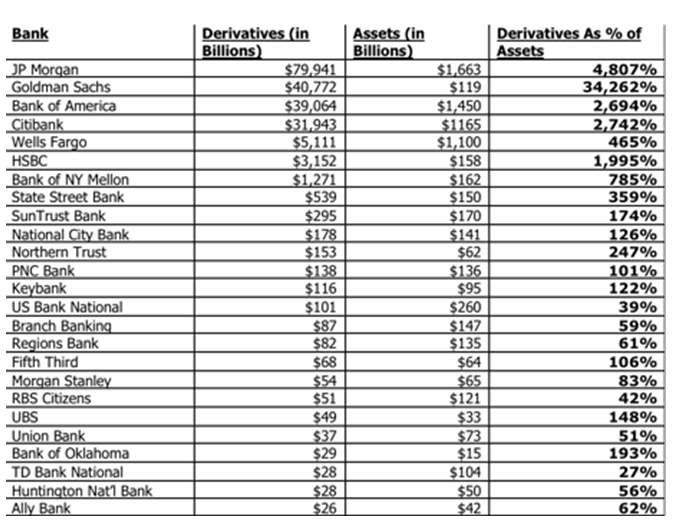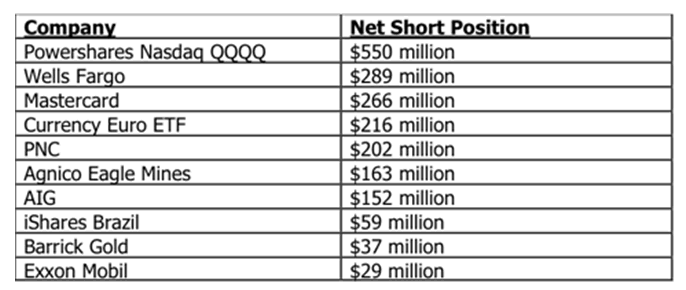Goldman Sachs Betting on Derivatives Collapse Sparked Financial Crash?
Stock-Markets / Financial Crash Nov 17, 2009 - 02:29 AM GMTBy: Graham_Summers
 Earlier this month, I detailed 25 US commercial banks that had trillions (with a “T”) of dollars’ worth of exposure to derivatives on their balance sheets. At the time, I stated that even if 4% of the notional value of these derivatives was “at risk” and only 10% of that 4% went bad, that you would wipe out the total equity at the five large US banks.
Earlier this month, I detailed 25 US commercial banks that had trillions (with a “T”) of dollars’ worth of exposure to derivatives on their balance sheets. At the time, I stated that even if 4% of the notional value of these derivatives was “at risk” and only 10% of that 4% went bad, that you would wipe out the total equity at the five large US banks.
Given how mortgage backed securities turned out (and those securities WERE regulated, unlike derivatives), I believe that most, if not ALL major banks in this country are insolvent or would be recognized as such if you marked the assets on their balance sheets at anything resembling market values.
As a review, here’s the chart I presented revealing the banks and their derivative exposure:

Paints quite a picture, doesn’t it?
This alone, explains in no uncertain terms that the Financial Crisis is anything but over. Sure the Federal Reserve may have pumped $800+ billion into the financial system, yes the Fed is buying some $1.2 trillion in mortgage-backed securities, and of course there are the Fed’s off balance sheet arrangements, which we cannot even begin to quantify.
But ALL OF THESE efforts amount to diddily-squat in the face of TRILLIONS and TRILLIONS in potential losses in the derivatives market.
Sure, the banks may not publicly state how much of their derivatives are “at risk” but when you’re talking about $200+ TRILLION (an amount equal to four times GLOBAL GDP) it doesn’t really matter how much is “at risk.” As I said before, if even 4% of this is “at risk” and 10% of that 4% goes bad, you’re talking $800 billion in equity wiped out (that’s the entire equity of the five largest commercial banks).
I know this… as does anyone who does a little homework on the banking industry. Including… THE BANKS THEMSELVES.
Goldman Sachs recently published its 13F, a quarterly filing in which all asset managers reveal their largest holdings. In it, Goldman’s asset management group reveals their largest long positions and their largest short positions.
Now, Goldie is widely held to be the “smartest” guys on Wall Street (not my opinion) so their net shorts (the stocks or companies they’re betting AGAINST) were particularly interesting to me:

The above positions combine Goldman’s long and shorts (stock and option based positions) for the NET short positions. In simple terms, Goldman MAY be long these companies, but because the bank is ALSO shorting them (and shorting more shares than it is going long) it has NET short positions. Put another way, these are the companies or positions that Goldman is betting the most money on falling in the future.
For starters, FOUR of the top 10 are financial companies. The largest financial short is Wells Fargo, which Goldman has committed $289 million to betting against. After that it’s Mastercard ($266 million), then PNC ($202 million), and finally AIG ($152 million).
Looking at Goldman’s positions, it’s plain as day that Wall Street’s “finest” do NOT believe the financial crisis is over (why are they betting against the banks if they do?). It’s also clear that Goldman’s analysts have noted as I have that both Wells Fargo and PNC both have massive exposure to the derivatives market (the fact that Goldman ALSO has massive derivative exposure is beyond ironic).
However, where things get absolutely absurd is Goldman’s short position of AIG. Goldman, as has been widely documented, was one of the largest benefactors of AIG’s bailout (the then investment bank had MASSIVE counter party exposure to AIG’s toxic balance sheet). To see Goldman now betting AGAINST AIG after receiving $13 billion in tax payer money to insure the former didn’t go under along with the latter is outrageous (if not infuriating) to say the least.
On a final note, I wanted to point out Goldman is also shorting a Euro index (betting against that currency) as well as two gold mining companies (Barrick and Agnico Eagle Mines). This indicates that Goldie is bearish on both the euro and gold which hints that Wall Street’s finest are likely betting on a US Dollar rally (that would, after all, be the most obvious catalyst for a correction in gold and the euro).
To be blunt, it’s clear that Goldman (like me) believes the financial crisis is nowhere near over: four of its top ten largest shorts are financial companies. It’s also worth noting that Goldman is betting against gold and the euro. Given Goldman’s incredible access to and close relationship with the regulators and federal government, I see this as further proof that we may be seeing another stock crisis triggered by a Dollar rally in the near future.
Indeed, if the Dollar rallies we could very well see stocks AND commodities COLLAPSE. To that end, I’m already preparing investors for what’s to come with a FREE Special Report detailing THREE investments that are set to explode when the next Crisis hits. I call it Financial Crisis “Round Two” Survival Kit. Not only can these investments help protect your portfolio from the coming carnage.. they can ALSO show you enormous profits: they returned 12%, 42%, and 153% last time stocks collapsed.
Swing by www.gainspainscapital.com/roundtwo.html to pick up a FREE copy today!
Good Investing!
Graham Summers
Graham Summers: Graham is Senior Market Strategist at OmniSans Research. He is co-editor of Gain, Pains, and Capital, OmniSans Research’s FREE daily e-letter covering the equity, commodity, currency, and real estate markets.
Graham also writes Private Wealth Advisory, a monthly investment advisory focusing on the most lucrative investment opportunities the financial markets have to offer. Graham understands the big picture from both a macro-economic and capital in/outflow perspective. He translates his understanding into finding trends and undervalued investment opportunities months before the markets catch on: the Private Wealth Advisory portfolio has outperformed the S&P 500 three of the last five years, including a 7% return in 2008 vs. a 37% loss for the S&P 500.
Previously, Graham worked as a Senior Financial Analyst covering global markets for several investment firms in the Mid-Atlantic region. He’s lived and performed research in Europe, Asia, the Middle East, and the United States.
© 2009 Copyright Graham Summers - All Rights Reserved
Disclaimer: The above is a matter of opinion provided for general information purposes only and is not intended as investment advice. Information and analysis above are derived from sources and utilising methods believed to be reliable, but we cannot accept responsibility for any losses you may incur as a result of this analysis. Individuals should consult with their personal financial advisors.
Graham Summers Archive |
© 2005-2022 http://www.MarketOracle.co.uk - The Market Oracle is a FREE Daily Financial Markets Analysis & Forecasting online publication.



